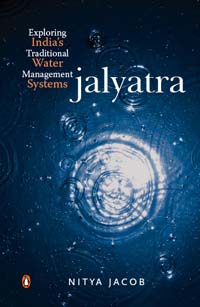Nitya Jacob
Jalyatra: Exploring India's traditional water management systems
Posted on 14 May, 2011 07:34 PM Jalyatra - Exploring India's traditional water management systems, by Nitya Jacob is an ecological travelogue that looks at links between water, society and places It describes in detail what existed, how it fitted into the socio-cultural milieu and was appropriate for the local climate and geography. It then examines reasons for their decline, as indeed most have, in recent decades.
Jalyatra - Exploring India's traditional water management systems, by Nitya Jacob is an ecological travelogue that looks at links between water, society and places It describes in detail what existed, how it fitted into the socio-cultural milieu and was appropriate for the local climate and geography. It then examines reasons for their decline, as indeed most have, in recent decades.
While recording the dismal state of traditional systems, the author stumbles upon small initiatives that have brought about significant transformation across regions. It refers to noisy hidrums and gharaats, the river-run flour mills of Uttaranchal, the technologies whose potential has yet to be fully realised. It looks at water harvesting structures of southern India—the eris and ooranis. However, it admits that the average person is singularly uninterested in protecting the environment.
Jalyatra captures the efforts of NGOs and enlightened individuals striving to revive these systems. It makes the case for a mass movement to revive traditional water management systems, especially village ponds, across the country as the way to ensure water security in India. In Chambal, the author meets Brij Mohan Gujjar, dacoit turned water conservationist, who is doing valuable work on the check dams designed to control the flow of water in the ravines; and in Shillong, Lan Potham shows him the uses of the easily available bamboo to construct the shyngiar which irrigates his areca nut plantation.
Mining - An increasing threat to our rivers - Article by Nitya Jacob
Posted on 20 Dec, 2010 12:29 AMContent Courtesy: Solution Exchange and Nitya Jacob
Author: Nitya Jacob
India’s arteries are choking. Her rivers, the lifeline of hundreds of millions, are over-taxed, polluted and encroached. They are being mined, dammed and emptied of water. Save for the four monsoon months, most rivers are streams of drains, depending on how many cities they pass through. This year people gaped in awe at the River Yamuna (I am sure they were over-awed by other rivers elsewhere too) as for the first time since 1978 looked like a river and not a drain.
Regional meeting - "Mazhapolima", Thrissur
Posted on 02 Jun, 2009 09:22 AMForwarded to the Portal by: Nitya Jacob, UN 
Dr Kurien Baby, District Collector of Trissur, Kerala, and Solution Exchange Water Community are organizing a regional meeting to discuss the effects of the Mazhapolima program. The dates are 16-17 June 2009, and it will be held in Trissur.
Background
Kerala has among the highest well densities in India, and 71% of the population depends on them for drinking water. The aggregate household investment in the state on wells is pegged at Rs 1800 crore and they have a combined yield potential of 6.6 million cu m per day. That works out to a water availability of 197 litres of water per capita per day (lpcd), well above the government's prescribed norm of 140 lpcd. These wells are threatened. Despite an annual rainfall of 3,000 mm, 70% go dry in summer. The surface runoff is heavy, and therefore groundwater levels in several blocks have fallen sharply, and coupled with saline intrusion at an accelerated pace, have led to water quality problems.
New book:"Jalyatra: Exploring India's Traditional Water Management Systems"
Posted on 22 Apr, 2008 04:50 AM The book published by Penguin India, explores traditional water management systems in 8 states of India, including Delhi, and is writte
The book published by Penguin India, explores traditional water management systems in 8 states of India, including Delhi, and is writte